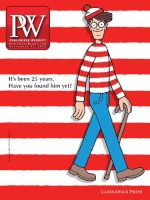It’s been three years since HarperCollins became the first publisher to move to a digital catalogue. Since then Random House has gone entirely paperless, while others, like Perseus Books Group, offer both. Some provide Edelweiss printouts on request. Yet despite the push to digital, a handful of publishers, primarily art and literary houses, are committed not just to print books but to hardcover catalogues with high production values that give greater meaning to their lists.
Many of these catalogues are collectible, like that of India’s Seagull Books. Book buyer Paul Yamazaki at San Francisco’s City Lights insists on two copies, one that he takes home and another for the staff. The Calcutta-based publisher of English-language translations of European literature does have a digital catalogue, used primarily by its distributor, the University of Chicago Press. But the two catalogues are separate. Last year’s annual hardcover one, a 412-page extravaganza with gilded edges, colorful endpapers, original essays, and four-color art centered on the idea of “The Loss Library.” It included essays by booksellers Rick Simonson, book buyer and co-director of the author-readings program at the Elliott Bay Book Company in Seattle, and Chuck Robinson, co-owner of Village Books in Bellingham, Wash., alongside excerpts from Swiss novelist and playwright Max Frisch among others. An essay by Alan Thomas, editorial director for the Humanities and Social Sciences at the University of Chicago Press, gets to the heart of the matter, when he asks, “What is a catalogue? A book of promises by author and publisher. An enticement and an offering. A venture.”
While Seagull’s digital catalogue may be able to do much of that, its hardcover catalogue goes further. As founder Naveen Kishore views it, the print edition is “our glass-bottle-with-an-SOS-message-to-the-world, our carrier pigeon, our ‘ambassador.” Beyond that he finds it an asset in acquiring books. “Authors often tell their agents they want to be in it. The catalogue is the event that makes it possible to acquire books that would be very hard to acquire otherwise,” says Kishore.
At Germany’s Steidl, distributed in the U.S. by Innovative Logistics, its hardcover catalogues share many of the same production values as its photography books, and are occasionally incorporated into exhibits of the artists it publishes. The cover of its spring/summer catalogue, illustrated by Karl Lagerfeld, focuses on print books and features the July release Paper Passion, which has since sold out its first 300 copies. Nestled inside the book is a bottle of perfume that captures the scent of a newly opened book. It’s the same feeling that Steidl tries to create with its print catalogues, which it gives to booksellers and includes with Internet orders. “We love printed books, their touch and smell, and you can experience that while thumbing through our catalogues,” says Susanne Schmidt at Steidl.
At Assouline, which is all about style, the catalogue is both a selling tool and an upscale marketing piece distributed to VIP customers at its stores and designed to resemble a title in its Mémoire Collection. “I have just one word to explain the catalogues,” says founder Prosper Assouline. “Respect. I really want to respect what we are doing. We have to present who we are. We publish 50 books a year, and all the books have the same target. It is about style.” This fall, Assouline will give away 20,000 catalogues; next year Prosper plans to up the print run to 30,000. “It costs us a little money,” he acknowledges, but adds, “It has to be like a gift, not a catalogue.”
For booksellers, print makes buying more pleasurable, and arguably more effective. “The excitement and nuance is ebbing from book buying,” says Sean Halpert, book buyer for the Museum of Fine Arts, Boston, about the digital shift. “I would bring catalogues home, mark them up on the T [subway], enjoy perusing them. I couldn’t wait to bring home the Knopf/Vintage catalogue, read all the descriptions, make notes in it, and actually think about the titles.”
“The catalogue is the beginning of a dialogue,” says Yamazaki. “Text on a screen is information exchange. The effort to review 800 or more titles in a digital ‘catalogue’ is excruciating, and not just in an existential sense. Eye strain, repetitive stress syndrome, lack of focus make the digital catalogue a less effective tool to sell books.” On the other hand, he adds, “a well-designed [print] catalogue is a delight to look at and read.”
Elliott Bay’s Simonson compares digital catalogues to self-checkout; he uses them but prefers print. In his essay in the Seagull catalogue, he writes, “I will relish more those [catalogues] that still present themselves, physically handed over or physically sent, that have their weight, texture, pages, a cover, asking you to open... and see what’s in store.”



 Volume 259
Issue 38
09/17/2012
Volume 259
Issue 38
09/17/2012





